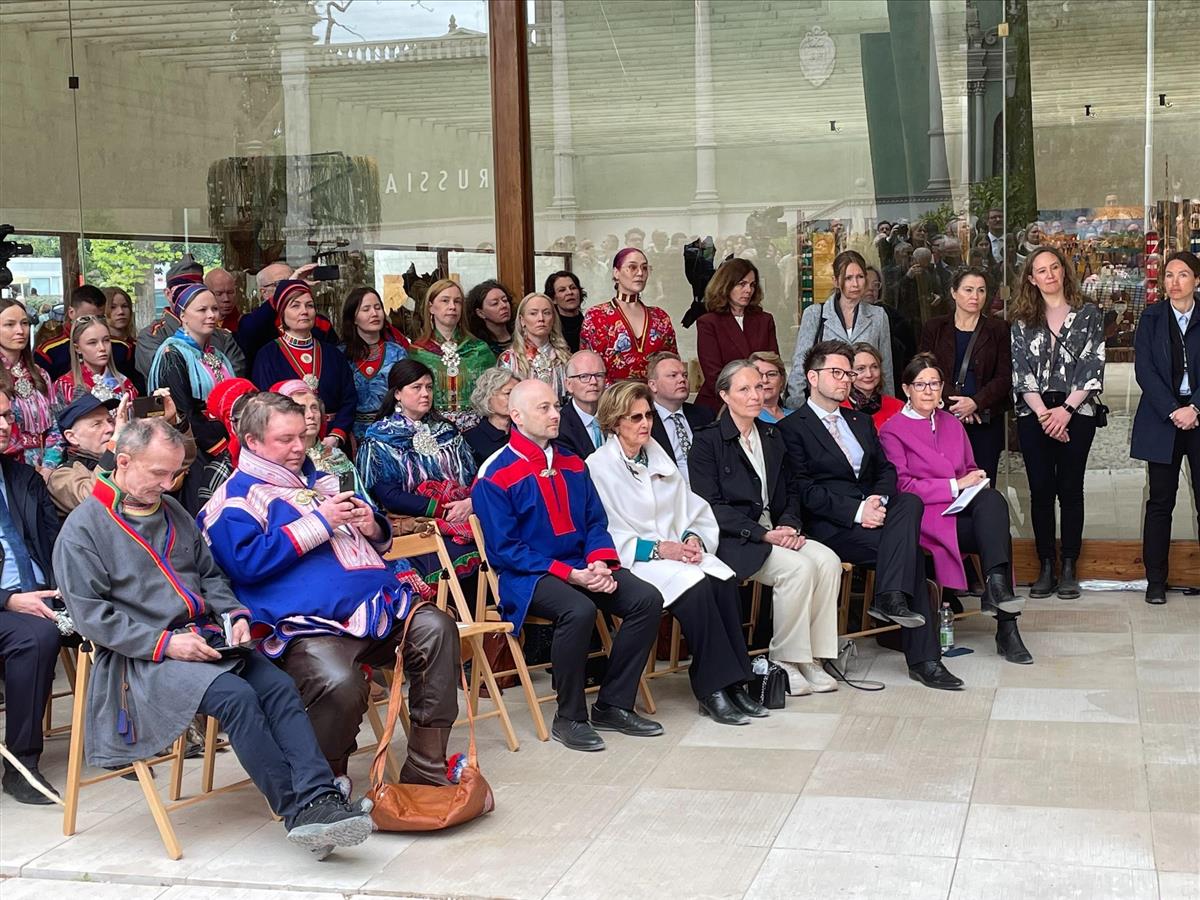On behalf of the Sámi parliaments in Finland, Norway and Sweden, it is my privileged and great honour to express our warm welcome to Her Majesty Queen Sonja, all excellencies, ministers, artists, curators, elders and all Sámis and others who have joined us for this great occasion today.
 Åse M. P. Pulk/Sametinget
Åse M. P. Pulk/Sametinget
Mun lean Elle-Rávnná Eli Silje ja lean Norggabeale Sámedikki presideanta. Lea munnje hirbmat stuorra gudni ja illu beassat ávvudit dán máilmme dáhpáhusa dáppe dinguin Venezias.
I am Silje Karine Muotka and I am the president of the Sámi Parliament of Norway, but equally I am the representing president of the Sámi Parliamentary Council, which is the common political platform of the three Nordic Sámediggis. Together with my colleagues Tuomas Aslak Juuso from the Sámi parliament Finland and Håkan Jonsson from the Sámi parliament Sweden, we are united in the parliamentary council, and we work together on issues important to us.
Today marks a huge achievement, gathered here at this important international art scene to celebrate Sámi art and Sámi artists. The inspiration, the vision, the knowledge, dedication, preparation, skills and work that the artists have done with the art here is astonishing.
Máret Ánne Sara, Paulina Feodoroff and Anders Sunna! I am grateful that You share and give so much of Your personal stories in the art we now can show to a much bigger audience. This will give new groups a chance to see some of our culture and the strength and the brutal challenges we face when it comes to Sami rights, extractive industries and trying to handle the consequences of climate change.
You are three artists being showcased here today, but you represent so much more than just yourselves. Your stories are our stories. You voice our challenges, our strength, and make us visible – through you and your art.
You represent three distinctive artistic expressions, but with a common denominator with the fight for land rights and rights to exist as indigenous humans in a world filled with limitations and structuralism that seeks to make indigenous existence illegal.
From Máret Ánne Saras fight for her brother’s and the extended family’s rights to exercise a traditional primary livelihood, and Anders Sunnas struggle against the violence and internal turmoil that is everyday seeking to exterminate his and his family’s reindeer herding and Pauliina Feodoroff whose art highlight’s the feminism as well as the remains of ancient cultural lands – lost from access long time ago, but that is still channeling through its descendants – with a strong message.
Together you demand for the right to exist, the right to live and be who genuine indigenous Sámi individuals with all your traditional rights intact – an ideal we as Sámi politicians also seek to fulfil every day - the right to self-determination.
The present situation in Europe is a harsh reminder to all of us that our lives and existences are fragile tokens of life and politics. As Sámis we are reminded about our geopolitical vulnerability, with brothers and sisters on the other side of a border defined by massive power structures and struggles beyond our control.
In the middle of all this we as a people meet the global challenge of climate change with wild and more extreme weather and right now our people have been working day and night since November trying to secure the reindeer herds due to the ice layered snow that keep the animals from finding food in winter gazing areas. At the same time, we are faces with even more extreme expectations with regards to the so called «green shift». The governments are pushing wind industry power, mineral companies, and power lines. This is why we see the green shift as a way of green colonization.
Our values, our presence, and our practices such as listening and to be one with nature, our ways hold deep and necessary knowledge about surviving in the lands we live off, in and with. I truly believe this knowledge and thinking is important beyond ourselves.
That is why events like this event are defining. During the many struggles Sámis have experienced throughout history, art has been an important companion – often as a unique guiding light.
Like in the 1970s during the active Sámi Movement period, there was a strong art presence – the Máze joavku – and I am equally proud that two of those artists are selected to the Venice biennale main exhibition, namely Britta Marakatt Labba and the late Aage Gaup.
The struggle back then was among others to hinder traditional lands and waters being misused – a struggle that unfortunately continues today. When looking at all the industrial plans involving traditional Sámi territories today, it is quite intimidating to face how vulnerable the Sámi society is when the hard rights – the rights to land and waters – are still not in the hands of the Sámis.
Still today Sámi land rights are at the mercy of the court systems and their benevolence to grant the Sámi right to their own traditional territories.
Even when there are important landmarks wins, such as the Fosen case, where the construction of a wind power industry on traditional Sámi territory was convicted as illegal, the Norwegian government is failing to abide its own judicial system, creating a democratic diffidence within the state.
Therefore, art is so meaningful, repeatedly it tells the stories so difficult to convey to the outside world, it opens people hearts. But even more important is the way art speak of the hope we need to face the challenges we endure. This hope and inspiration speak a language known to all of humanity. That is why today is such an important day.
Finally, I want to extend my gratitude to all who have materialized this moment, with a special mention of OCA with Katya Garcia-Anton and her team.
Thank you – giitu!